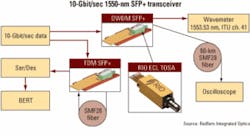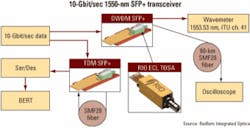Currently under development in the Fibre Channel world for 8-Gbit/sec applications, the SFP+ next-generation form factor promises to be 30% smaller, burn less power, require fewer components, and be less expensive than the XFP form factor. For this reason, vendors in the cost-sensitive 10-Gigabit Ethernet (10-GbE) market are making a strong push to standardize SFP+ for use in 10-GbE applications.
With every new Ethernet speed, data rates tend to increase by a factor of ten, which typically results in a price premium for new modules. Fibre Channel data rates, by contrast, merely double with each new speed. Folks in the Fibre Channel world, therefore, are accustomed to purchasing new modules at newer rates for roughly the same price or at only a slight premium over existing modules. But this did not prove to be the case for 10-Gbit/sec Fibre Channel modules, which were priced much higher than 1- and 2-Gbit/sec versions. As a result, the Fibre Channel industry developed a much more widely adopted 4-Gbit/sec version, which is in a similar ballpark, price-wise, to its 1- and 2-Gbit/sec counterparts. Inspired by the success of the 4-Gbit/sec module, the Fibre Channel folks decided to double the speed again with an 8-Gbit/sec design.
“In the past, the way people have attacked that is to put more silicon in the module,” notes Norm Swenson, CTO of ClariPhy Communications (Irvine, CA). “The XFP, for example, has a retimer inside the module in both the transmit and receive directions. But when you start adding those components inside the module, you start adding cost that the Fibre Channel community was not that eager to adopt.”
For this reason, the industry-specifically the American National Standards Institute (ANSI) Technical Committee T11-opted to return to the simple module design that had worked so well at the lower data rates. This design includes only the silicon that needs to be in the module: a laser, a laser driver, a transimpedance amplifier (TIA), and maybe some type of post-amplifier on the receive side. “The premise is that you will keep the electronics and optics very simple, just as it is in the case of 1, 2, and 4 gig,” explains Ali Ghiasi, chief architect at Broadcom (Irvine, CA). “From a component perspective, it’s a very simple E-to-O, O-to-E converter.”
The T11 Group soon determined that if it could develop an SFP+ device for 8-Gbit/sec Fibre Channel applications, there might be industry interest in a 10-Gbit/sec version as well. The 10-GbE folks, for whom cost is always paramount, immediately jumped on the bandwagon, realizing the SFP+ could be the catalyst they’ve been looking for to spark widespread 10-GbE adoption.
SFP+ benefits
Typically, OEMs expect to get 10 times the performance at three to four times the cost of the previous generation of device, but this model has not held true for 10-GbE. “If you look at prices for the SFPs and the prices of the XFPs, for example, you might see differences of 15x and up instead of 3x to 4x,” reports Swenson. “We would start to see much higher adoption rates for 10-Gigabit Ethernet if we could get the prices down to that 3x to 4x range that people are accustomed to seeing for that transition from the last-generation technology to the next generation.”
Typically, several electronics functions-such as the clock and data recovery (CDR), some SerDes/PHY functions, and perhaps electronic dispersion compensation (EDC)-reside inside the larger form-factor XFP, X2, and XENPAK optical modules, which are hot pluggable into the back of a switch. But the smaller size of the SFP+ would force some or all of these electronic functions to be housed outside the optical module, directly on the host board or line card, thereby reducing both cost and power consumption of the module.
That said, pulling the silicon out of the module and putting it on the line card appears, on the surface anyway, to be a zero-sum game. Isn’t that simply moving cost from one part of the system to another?
“You could argue this is just a left pocket, right pocket game,” admits Thomas Scheibe, product marketing manager with Cisco Systems’ Transceiver Module Group (San Jose, CA). “And it’s really cost neutral from a system perspective. The point is that moving the silicon or most of the ICs out of the optics and onto the line card enables higher integration on the line side, which, in the long run, should give you a cost advantage.”
The SFP+ enables the integration of functions currently sold in individual ICs, such as the CDR and EDC, into the SerDes, for example. “You could even potentially integrate the SerDes or the PHY with these added functionalities inside the MAC [media access controller] or the switch, just like Gigabit Ethernet,” adds Rami Kanama, vice president of sales and marketing at Redfern Integrated Optics (RIO-Santa Clara, CA). “In the lower data rate, a lot of these functionalities are integrated inside higher-level silicon.”
“It’s like having real estate in New York City versus Jersey City,” says Ghiasi. “You can think of the line card as a much lower-cost real estate. Long term, it may actually improve [the module manufacturers’] gross margins because they will be more vertically integrated-instead of buying components from an IC vendor, incorporating them into a module, and then reselling it to someone else.”
“Keeping the modules simple and putting some of the more complex signal processing into CMOS on the line card is the right way to go,” agrees Swenson. “Getting outside the module allows you to integrate a number of other functions in that single piece of silicon. It allows you to service multiple ports with that single piece of silicon, which you cannot do if you stay inside the module.”
The second critical advantage of SFP+ is the higher port density such a form factor would enable. Today, people are shipping 1-GbE line cards with 48 ports. Ideally, when end users replace one piece of equipment with another, they would like to have the same number of ports, notes Ghiasi. They don’t want to pull a 48-port switch only to replace it with a 4-port switch, because such a replacement would drive the need for more equipment, which would take up yet more real estate. Moreover, when you have fewer ports, the cost per port is much higher.
The form-factor conundrum
So promising is the SFP+, some people believe it will eventually supplant the XFP in 10-GbE applications. “We are at a very critical stage where the Ethernet guys have to decide, after the XENPAK and X2 form factors, whether to go to XFP-which I would consider an intermediate solution to ultimately the final package, which would be SFP+-or would they skip XFP and go directly to SFP+?” muses Kanama.
When asked about this scenario, Scheibe answers tactfully that there is always room for multiple versions. “If you look at Gigabit Ethernet, it started out as GBICs and then it moved to SFP, which I think is a similar transition in terms of form factor and size,” he notes. “GBICs have been around for 10 years, and they are still shipping. XFPs have been around for seven or eight years, and they are the popular one now for 1 gig. But I think something similar would happen on 10 gig as well,” Scheibe admits. “You are going to see a trend from XENPAK, now the most popular, to X2, and the question is with XFP and SFP+, how do they line up with each other?”
Like Scheibe, Ghiasi does not believe the other form factors will simply disappear. However, he is more outspoken in his enthusiasm for the smaller form factor. Though SFP+ may have entered the game a little late, Ghiasi believes it could be the first to reach the coveted 1 million-units-shipped mark. “If you can support 48 SFP+’s on one line card, even if you populate 50% of them, you’re still shipping 24,” he reasons. “It may not be unreasonable for SFP+ to ship a million units before XFP reaches that point.”
That said, not everyone is ready to hand the market to SFP+ yet. While the module might work well for shorter-reach applications, some question whether the form factor’s ultimate size and power limitations will prevent it from supporting links longer than 20 km without an advance in laser technology-which RIO claims it has achieved. Similarly, EDC vendors looking at the enterprise space point out that a new interface will have to be defined between the specialized PIN/TIA that will remain in the module and the EDC-enabled chips on the board. The definition of such an interface could take years, they say-which might be necessary to give the EDC vendors enough time to tweak their chips to handle the additional dispersion caused by the board trace between the module and the chip.
Timeline for deployment
From a technical perspective, the T11 Group intends to ratify the standard by year-end. The group still must agree on an interface and a mechanical envelope, reports RIO’s Kanama, but “once that’s done, I would say next year’s OFC, you’ll see a lot of SFP+.”
Ghiasi agrees, noting that some vendors already are alpha sampling SFP+ devices to OEMs for evaluation. In terms of real product, he expects to see designs based on SFP+ by mid-2007.
For its part, RIO chose this year’s OFC to make its statement about SFP+. Working in collaboration with Broadcom, RIO conducted a feasibility demonstration of its directly modulated, 10-Gbit/sec external-cavity laser (ECL) transmitter optical sub-assembly (TOSA) for long-reach 40- and 80-km DWDM in an SFP+ transceiver module. “Unless you can show that [SFP+] actually can go 40 km to 80 km, the system vendors are hesitant to get into it at this point,” admits Kanama. “But this demonstration showed them that yes, we can dive into it and start working on something that’s going to work ultimately for 10 Gig, not only 8 Gig. That’s also good news for SONET as well.”
Because the T11 Group has yet to define a mechanical envelope, RIO has developed its own concept. The SFP+ must feature the same port density as the SFP, which means it must utilize the same 20-pin connector. It also needs to be the same width. But length-wise, systems are not as restricted on board space, which affords vendors like RIO a little more wiggle room to create a device with a larger surface area to dissipate more heat. RIO developed an SFP+ that is the width of an SFP and the length of an XFP. It still fits into the SFP cage, says Kanama, and it has the 20-pin connector. This architecture is currently under discussion, he reports. “The other idea is to keep it in the same mechanical envelope as SFP, which is basically SFP length and SFP width. And that’s a possibility as well, obviously,” he adds.
